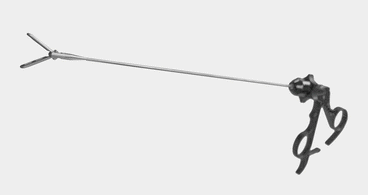Fig. 8.1
Differences between 2-, 5- and 10-mm optics
A significant obstacle to needlescopic surgery is the limited visualization achieved with 3-mm and smaller laparoscopes. Minilaparoscopes are available from Olympus Medical Systems Co. (Tokyo, Japan), Aesculap (Tuttlingen, Germany), Karl Storz-Endoskope (Tuttlingen, Germany), and Stryker (Kalamazoo, MI, USA) [1]. The Stryker Ideal Eyes™ line includes a 2.9-mm pediatric scope, 20-cm in length. Karl Storz-Endoskope offers two 30-degree laparoscopes, a 2.4-mm scope and a 3.3-mm scope, 18 and 25 cm in length, respectively. Aesculap has 2- and 2.5-mm, 0-degree laparoscopes, 22 and 30 cm, long respectively. Because of the limited optics and limited available laparoscopes, many needlescopic procedures are performed with a fairly large umbilical port, which accommodates a larger laparoscope and offers better visualization. For procedures such as cholecystectomy, a needlescopic umbilical port site would most likely require enlargement for extraction of the gallbladder.
8.2.2 Laparoscopic Instruments
Currently several minilaparoscopic instrument sets are commercially available: the MiniSite™ disposable instrument set manufactured by Covidien (New Haven, CT, USA), the 3-mm minilaparoscopy set from Karl Storz-Endoskope, and a similar set of instruments from Stryker [1].
The MiniSite™ MiniShears™ (Covidien) 2-mm instrument with unipolar cautery is applicable to a variety of endoscopic procedures for mobilization and transection of tissue. This instrument has a 2-mm diameter insulated shaft that is approximately 33 cm in length, it is designed for introduction and use through the MiniPort™ (Covidien) introducer sleeve. The scissors blade has a cutting edge approximately 5.9 mm in length, and the maximum blade opening is 5.9 mm.
The 3-mm minilaparoscopy instrument set manufactured by Karl Storz-Endoskope (Fig. 8.2) is a completely reusable set of instruments 36 cm long. A full complement of instruments is available including graspers, dissectors, scissors, electrocautery, suction device, and needle holders for intracorporeal suturing. The major advantage of this set is that it is made up of the longest currently available needlescopic instruments, which are thus versatile and can accommodate thick abdominal walls as well as operations in which relatively long instruments are needed. In addition to these 3-mm-diameter, 36-cm-long instruments, Karl Storz-Endoskope offers shorter 3-mm instruments (20 and 30 cm in length) as well as a line of 2-mm instruments in lengths of 20 cm and 30 cm instruments, but that set is available only in 20-cm lengths.


Fig. 8.2
The 3-mm minilaparoscopy system (Karl Storz-Endoskope)
The Sovereign® mini-instrument set (Aesculap) is another set designed for minilaparoscopy. These instruments are actually 3.5 mm in diameter, which by strict definition does not make them needlescopic. They are available in lengths of 20 and 29 cm. The set of Soverign® mini-instruments (Aesculap) work through a reusable trocar system and includes graspers, scissors, dissectors, and needle holders. Although this line does not fall under the definition of needlescopic surgery devices, it includes small-diameter instruments that are introduced through a 4-mm trocar. In comparison to a 5-mm instrument setup, such small instruments and trocar should reduce abdominal wall trauma. This is an example of compromising size for strength. These instruments are more rigid than the 2-mm instruments, making them particularly suitable for operations that require strong instruments, yet they still decrease abdominal wall trauma.
A new-generation 2-mm instrument called BJ Needle (NITI-ON Co., Ltd., Chiba, Japan) (Fig. 8.3 ) was recently introduced. This new instrument, in comparison to first-generation 2-mm instruments, allows more rigid grasping with less bending of the instrument shaft. The shaft is a 2.1 mm in diameter. We anticipate that the outcomes achieved with such instruments, in terms of operation time and the surgeon’s stress level, will be similar to those achieved with 3-mm instruments.


Fig. 8.3
BJ needle (NITI-ON)
Endo Relief forceps (Hope Denshi Co., Ltd., Chiba, Japan) (Fig. 8.4), which is used to grasp and retract the organs, consist of a 2.4-mm shaft and a 5-mm head, and the two parts are joined intraoperatively. To join the two parts, a 5-mm port and a 2/3-mm port are needed, because a 2/3-mm shaft is connected to the 5-mm head after incorporation of the shaft guide, the 2.4-mm shaft is moved from inside to outside the abdominal cavity through the 2/3-mm port. Manipulation of this device is similar to that of 5-mm instruments except for the easy bending of the shaft. The head cannot be easily changed during the operation.










